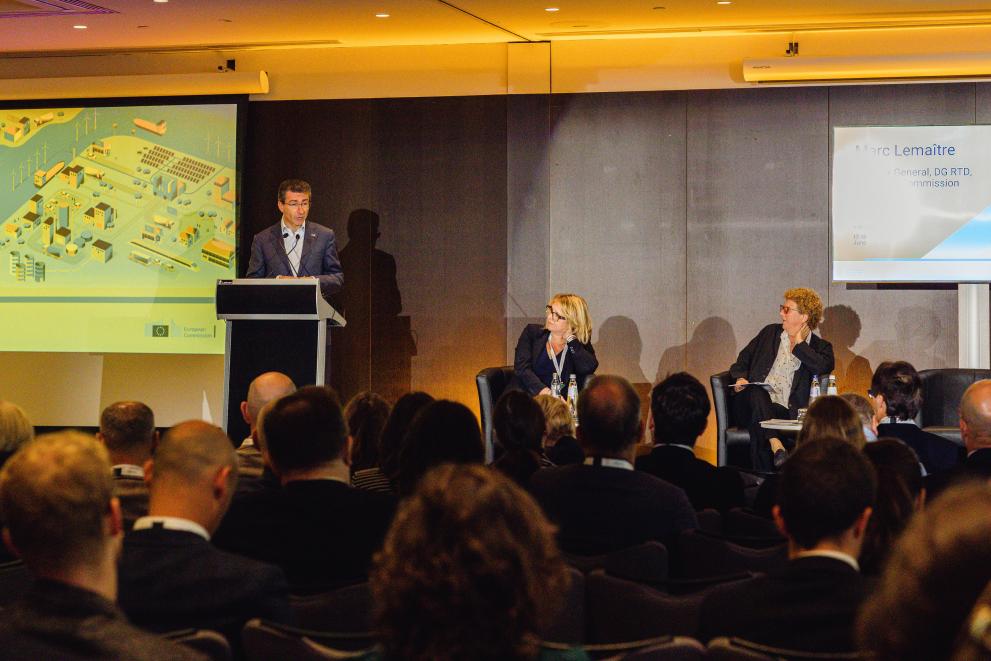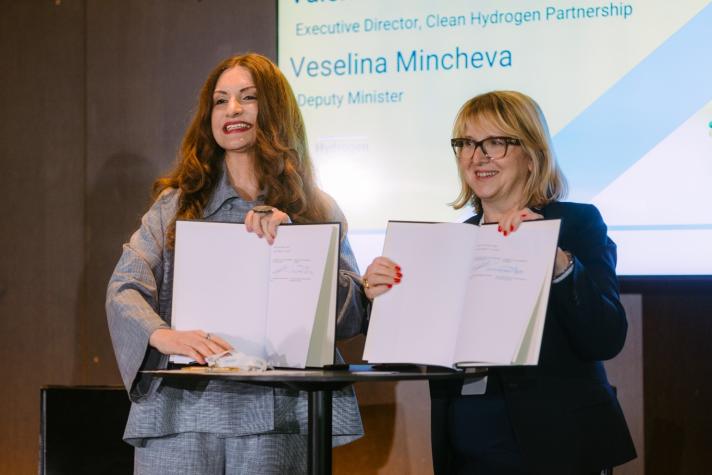
Hydrogen Valley Days marked a new milestone in efforts to further develop Europe’s green hydrogen regions, with the signing of the first memoranda of co-operation with national and regional authorities and the announcement of a facility designed to get more hydrogen projects to the financing stage.
Held in Brussels on 17 and 18 June 2024, this first edition brought together stakeholders from Industry, research, Member States and Regions, to accelerate cooperation for the development of Hydrogen Valleys across Europe.
‘Hydrogen valleys are emerging all over Europe, fostering regional progress and innovation. They are key for Europe’s future and for a green hydrogen transition,’ said Valerie Bouillon-Delporte, the Executive Director of the Clean Hydrogen Partnership.
In his keynote speech, Mark Lemaitre, Director General of DG Research and Innovation, highlighted that Hydrogen Valleys are a priority for the Commission, as steppingstones to a European and global hydrogen economy and that a more coordinated research and innovation framework bringing in national, regional and EU funding is needed.
He also announced the upcoming publication of a Staff Working Document :" Towards a roadmap for accelerating the deployment of Hydrogen Valleys across Europe: challenges and opportunities“, outlining the strategic priorities and actions that are currently ongoing or planned. Over the two days, delegates discussed the state of hydrogen valleys in Europe, ways to accelerate development of hydrogen projects, financing, and skills development.
The event was an indication of how important hydrogen technology and the valleys have become to the European Commission’s climate targets. It is likely to become an annual highlight on the hydrogen calendar.
A better policy environment
Rosalinde van der Vlies, Clean Planet Director at the Commission’s Directorate-General for Research and Innovation (DG RTD) stressed the importance of research as a means to reduce the costs of the technology, support manufacturing and ensure the EU remains a leader in the sector.
The EU’s Net Zero Industry Act, for example, supports green technologies by acting as ‘regulatory sandbox’ – exempting hydrogen producers from rules that have hampered increased hydrogen production. In addition, skills development and more private sector funding is vital. Collaboration across borders, both with member states and regions, would help accelerate deployment, she said.
Worldwide, close to 100 Hydrogen valleys are at different stages of completion, around 70 of them in the EU, according to the Mission Innovation Hydrogen Valley Platform. Starting with BIG HIT in the Orkney Islands, the Clean Hydrogen Partnership had been supporting 16 of these valleys in 15 EU countries with EUR 200 million in EU funding since 2015. Fifteen of them are ongoing and represent a total investment of over EUR 1 billion. They are expected to produce in excess of 21 000 tonnes of hydrogen per year to contribute to the EU’s RepowerEU targets.
Cooperation with managing authorities
The first day of the event concluded with the signing of three memoranda of co-operation between the Clean Hydrogen Partnership and Croatia, the Friuli-Venezia Giulia Region of Italy and Bulgaria.
Ms Van der Vlies said the aim of these agreements is to create a ‘more robust and mutually beneficial partnership framework’. A total of 10 regions were selected for co-operation agreements following a call for expressions of interest the Clean Hydrogen Partnership made last year. The remaining memorandums will be signed later in June.
After she signed the agreement, Bulgaria’s Deputy Minister of Innovation and Growth Veselina Mincheva said more structured co-operation between the Clean Hydrogen Partnership and regions would ensure better knowledge transfer, capacity building and financing.
The Hydrogen Valley Facility
Currently only a small fraction of the projects included in the Platform have reached final investment decision stage, said Mirela Atanasiu, head of Operations and Communications of the Clean Hydrogen Partnership
Ms Atanasiu said the future Hydrogen Valley Facility, would be an extension of the Clean Hydrogen Partnership’s support framework which aims to increase the maturity of hydrogen valleys projects through project development, technical, financial and legal assistance. The aim is for it to help valleys develop a plan to get through their pre-feasibility stage to final investment decision. The tender, with a budget of EUR 12.5 billion has been published by the partnership on 25 June 2024, following the event.
Markus Kaufmann of consultancy Roland Berger said the trend reflected challenges that all hydrogen projects faced: the cost of hydrogen is not decreasing fast enough, the technology needs to be improved and the policy environment made more favourable.
Skills for civil servants
A skilled workforce is needed, not only to build, operate and maintain the new equipment, but also in the banking and finance and public sectors.
Permitting had been identified as one of the major hurdles to advancing hydrogen projects. Getting the necessary paperwork currently takes between 6 to 9 months in Western Europe, and could take years in Eastern Europe, said Ms Atanasiu, with the Clean Hydrogen Partnership considering to publish a call next year for the training of public administrations.
Delegates from Greece and Norway said both countries are looking at developing information sessions they called ‘masterclasses’. These would range from informing policymakers on the basics of the hydrogen economy, to sessions on project planning and issuing permits. Another gap was training for bankers, investors and venture capitalists who are currently not knowledgeable enough to evaluate the feasibility of hydrogen projects.
The fact that permitting has become a problem is an indication that technology and engineering has progressed to the point where more projects are making permit applications. Governments could tackle this directly by training staff and digitalising their processes said Markus Kaufmann, a consultant from Roland Berger.
More private investment
It was vital to bring more private investors into hydrogen valley projects, said William Stevens, group Managing Director of Tech Tour, a European technology entrepreneurship and investment community.
This could be done through better cooperation between industry and government, more demonstration projects to convince investors, legislation to help create a more predictable business environment and easier permitting processes.
The slow pace of progress in implementing projects led Aivars Starikovs, chairman of Latvian Hydrogen Association H2LV to say: ‘There are too many MOUs on the table. They are important to initiate projects, but we need more demo projects. People are tired of PowerPoint presentations. They need to see this box on wheels and drive with it.’
Scaling up
Hydrogen valleys are defined as geographic areas that combine renewable energy for hydrogen production, storage, transport and several end users.
Hydrogen technology had made massive strides in the last decade. Electrolyser capacity has advanced from 150 kW in 2011 to tens of megawatts currently. The BalticSeaH2 project, one of the few large-scale inter-regional hydrogen valleys in Europe, will soon deploy an electrolyser with a capacity of between 20-25 MW, as part of the plans to deploy electrolyser capacity at a larger scale.
While the first projects have focused on mobility, the trend has moved to decarbonising major industries. It had become clear that successful valleys needed a viable off-take and end-use plan. Connecting valleys and ensuring shared development of pipeline networks and refuelling corridors are also becoming more important, as is ensuring social acceptance of the technology.
Closing the event, Ms Bouillon-Delporte said hydrogen valleys are more than just a test bed, but rather form the missing link between the small and giga-scale facilities. They have reduced the time needed to scale up and are key to Europe’s competitiveness in the green transition.
Currently, hydrogen is like ‘champagne’, said Florentin de Loppinot, CEO of hydrogen refuelling station constructor and operator TEAL Mobility. ‘It’s only for special occasions. I hope that in the years ahead, hydrogen will be more widespread than champagne.’
EU Hydrogen week is scheduled from 18 to 22 November and will include a dedicated session on hydrogen valleys.
The Clean Hydrogen Partnership has recently published a new report on hydrogen valleys and the Mission Innovation Hydrogen Valley Platform: Making it happen: Hydrogen Valleys progress in an evolving sector.
A summary document with details outcomes of the event sessions will be available soon on the Clean Hydrogen Partnership website.
Slides
The slides are available on the event page.
Details
- Publication date
- 26 June 2024
- Author
- Clean Hydrogen Joint Undertaking


